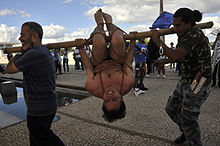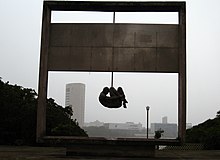
Pau de arara (Portuguese pronunciation: [ˈpaw dʒi aˈɾaɾɐ]) is a torture method in which the victim is bound by the ankles and wrists, with the biceps under a pole and knees over it. The pau de arara torture method was widely used by during the military dictatorship in Brazil. It was previously used during World War II by Wilhelm Boger at Auschwitz concentration camp, where it came to be known as the "Boger swing".
Name

Pau de arara is a Portuguese term that literally translates to "macaw's perch". The term originates from bird sellers' practice of tying the birds to a perch, where they also hang for transportation.
Torture technique

Pau de arara is a physical torture technique designed to cause severe joint and muscle pain, as well as headaches and psychological trauma. The technique consists of a bar placed between the victim's biceps and the backs of their knees while their ankles and wrists are tied together. The bar is then suspended between two metal platforms forming what looks like a bird's perch. This arrangement suspends them in such a way as to place their whole weight on the backs of their calves at a considerable mechanical disadvantage, severely straining their muscles, tendons and knees. They can shift some of their weight to the tops of their forearms temporarily to relieve the strain on their legs, but this position is also painful for the same reasons, and since arms are weaker than legs, respite is only momentary. By alternating between the positions to attempt to reduce their pain, eventually both their arm and leg muscles tire, leaving them in pain that they are unable to relieve.
This technique is believed to originate from Portuguese slave traders, which used pau de arara as a form of punishment for disobedient slaves. Its use has been more recently widespread by the agents of the political police of the Brazilian military dictatorship against political dissidents in the 1960s and 1970s and is still believed to be in use by Brazilian police forces, although outlawed. This torture technique was also used in Auschwitz during World War II, where it was known as the Bogerschaukel (the Boger seesaw) or Boger swing, named after the SS officer who first applied it, Wilhelm Boger.
Brazil's former president Jair Bolsonaro has cited his support for the technique, saying "the pau-de-arara works. I'm in favor of torture, you know that. And the people are in favor as well."
Pau de arara: la violence militaire au Brésil
François Maspero published Pau de arara: la violence militaire au Brésil in France in 1971. The book, which discussed military violence in Brazil, was banned in Brazil during the military dictatorship. It was first published in Brazil in 2013.
References
- "O Brasil segundo Jean-Baptiste Debret". Mundo Educação (in Brazilian Portuguese). Retrieved 2022-11-16.
- Caldeira, Teresa P.R. (2000). City of Walls. Crime, Segregation, and Citizenship in São Paulo. Berkeley: University of California Press. p. 109. ISBN 0-520-22143-5.
- "LEI Nº 9.455, DE 7 DE ABRIL DE 1997" [LAW No. 9,455, OF APRIL 7, 1997]. Palácio do Planalto: Presidência da República (in Portuguese). Government of Brazil. 1997-04-07. Archived from the original on 2010-11-24. Retrieved 23 January 2017.
Define os crimes de tortura e dá outras providências.
- "Ex-Auschwitz Aide Relates His 'Horror' At Camp's Killings". The New York Times. 11 January 1964.
- Leide, Henry (2007). NS-Verbrecher und Staatssicherheit. Vandenhoeck & Ruprecht. p. S. 259.
- "West Germany: The Auschwitz Business". Time. 1964-01-17. ISSN 0040-781X. Retrieved 2024-01-19.
- "When Auschwitz went to court – DW – 08/18/2015". dw.com. Retrieved 2024-01-19.
- Fishman, Andrew (2018-10-28). "Jair Bolsonaro Is Elected President of Brazil. Read His Extremist, Far-Right Positions in His Own Words". The Intercept. Retrieved 2018-10-29.
- ^ Reimão, Sandra; Maués, Flamarion; Nery, João Elias (2017-03-16). "France, 1971; Brésil, 2013 : deux éditions du livre Pau de arara et la mémoire de la répression". Brésil(s). Sciences humaines et sociales (in French). 11 (11). doi:10.4000/bresils.2236. ISSN 2257-0543.
- Box, Ben; Jane Eggington; Mick Day (2003). Brazil Handbook. Footprint Travel Guides. ISBN 1-903471-44-3.
- MacCann, Bryan (2004). Hello Brazil: Popular Music in the Making of Modern Brazil. Duke University Press. ISBN 0-8223-3273-6.